Usuario "alejandromorales"
Se han encontrado 15 Coincidencias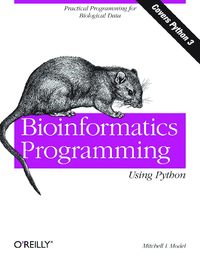
Bioinformatic programming with Python
Programación en el área de bioinformática utilizando Python como lenguaje de Programación
89 Visitas | 132 Descargas | 2015-07-17 18:16:31 | alejandromorales
The purpose of this book is to show the reader how to use the Python programming language to facilitate and automate the wide variety of data manipulation tasks encountered in life science research and development. It is designed to be accessible to readers with a range of interests and backgrounds, both scientific and technical. It emphasizes practical programming, using meaningful examples of useful code. In addition to meeting the needs of individual readers, it can also be used as a textbook for a one-semester upper-level undergraduate or graduate-level course. This book is designed to teach you bioinformatics software development. There is no computational biology here: no statistics, formulas, equations—not even explanations of the algorithms that underlie commonly used informatics software. The book’s examples are all based on the kind of data life science researchers work with and what they do with it. The book focuses on practical data management and manipulation tasks. The term “data” has a wide scope here, including not only the contents of databases but also the contents of text files, web pages, and other information sources. Examples focus on genomics, an area that, relative to others, is more mature and easier to introduce to people new to the scientific content of bioinformatics, as well as dealing with data that is more amenable to representation and manipulation in software. Also, and not incidentally, it is the part of bioinformatics with which the author is most familiar.
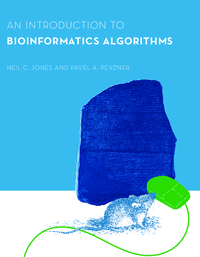
An Introduction to Bioinformatics Algorithms
80 Visitas | 124 Descargas | 2015-07-17 18:21:43 | alejandromorales
This is an introductory textbook on bioinformatics algorithms and the com- putational ideas that have driven them through the last twenty years. There are many important probabilistic and statistical techniques that we do not cover, nor do we cover many important research questions that bioinfor- maticians are currently trying to answer. We deliberately do not cover all areas of computational biology; for example, important topics like protein folding are not even discussed.
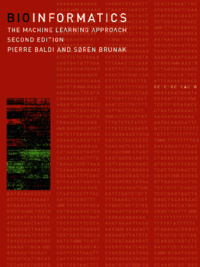
Bioinformatics: The machine Learning Approach
106 Visitas | 133 Descargas | 2015-07-17 18:27:24 | alejandromorales
The book is aimed at both students and more advanced researchers, with diverse backgrounds. We have tried to provide a succinct description of the main biological concepts and problems for the readers with a stronger background in mathematics, statistics, and computer science. Likewise, the book is tailored to the biologists and biochemists who will often know more about the biological problems than the text explains, but need some help to understand the new data-driven algorithms, in the context of biological data. It should in principle provide enough insights while remaining sufficiently simple for the reader to be able to implement the algorithms described, or adapt them to a particular problem. The book, however, does not cover the informatics needed for the management of large databases and sequencing projects, or the processing of raw fluorescence data. The technical prerequisites for the book are basic calculus, algebra, and discrete probability theory, at the level of an undergraduate course. Any prior knowledge of DNA, RNA, and proteins is of course helpful, but not required.

Bioinformatics Algorithms demonstrations in Excel
77 Visitas | 141 Descargas | 2015-07-17 18:31:14 | alejandromorales
This project presents demonstrations of selected computer science algorithms important in bioinformatics, implemented in the spreadsheet program Microsoft Excel. Spreadsheets provide an interesting platform for demonstration of algorithms, since various steps of the calculations can be exposed in a manner that is easily comprehensible to users with little programming experience. The algorithms demonstrated include two approaches to approximate string matching (dynamic programming and Shift-AND numeric approximate matching), Hierarchical Clustering (used in phylogenetic studies and microarray analysis of gene expression), a Naive Bayes Classifier for simulated microarray gene expression data, and a simple Neural Network. These demonstrations are designed to serve as instructional aids in bioinformatics courses

Lucene in Action
A guide to the Java search engine
74 Visitas | 121 Descargas | 2015-08-18 19:31:23 | alejandromorales
Lucene in Action delivers details, best practices, caveats, tips, and tricks for using the best open-source Java search engine available.

Manual de prácticas de ordenador con SPSS 15
Trabajo práctico con el software estadístico SPSS
117 Visitas | 107 Descargas | 2016-08-26 12:42:23 | alejandromorales
Cubre los temas normas generales del SPSS, estadística descriptiva unidimensional, relación entre dos variables, Probabilidad y variables aleatorias, Contrastes paramétricos y no paramétricos.

Analysing data using SPSS
Análisis estadístico de datos usando SPSS
71 Visitas | 66 Descargas | 2016-08-26 12:48:03 | alejandromorales
This document is intended to help you draw conclusions from your data by statistically analysing it using SPSS (Statistical Package for the Social Sciences).

Curso basico de análisis estadístico en SPSS
Análisis estadístico en SPSS
114 Visitas | 105 Descargas | 2016-08-26 12:52:37 | alejandromorales
Cubre los temas de estadística descriptiva, distribuciones de probabilidades y contrastes de hipótesis y análisis de varianza, regresión y series temporales

Manual del usuario del sistema básico de IBM SPSS Stattistics 21
61 Visitas | 87 Descargas | 2016-08-26 12:57:39 | alejandromorales
Cubre los temas de gestión de archivos de datos, análisis en modo distribuido, edición, preparación, transformación y trabajo con varios orígenes de datos, tablas pivotes, sintaxis de comando para SPSS y demás utilidades del software
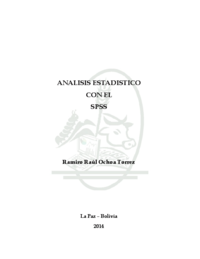
Análisis estadístico con el SPSS
127 Visitas | 157 Descargas | 2016-08-26 13:03:20 | alejandromorales
Guía práctica de trabajo con SPSS que cubre los temas de trabajo con las variables, distribución de frecuencias, medidas de tendencia central, dispersión y forma, prueba de T-Student, Chi cuadrado, análisis de varianza, regresión, correlación y determinación simple, diseños DCA y DBCA
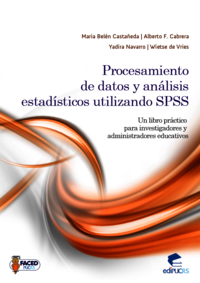
Procesamiento de datos y análisis estadísticos utilizando SPSS
129 Visitas | 188 Descargas | 2016-08-26 13:09:20 | alejandromorales
El propósito de este libro consiste en familiarizar al lector con el uso del 1programa SPSS (Statistical Package for the Social Sciences) para Windows, de modo que pueda experimentar y realizar análisis adecuados para la investigación educativa con diversas técnicas estadísticas. La organización de los apartados facilita el autoaprendizaje. Además, para fines prácticos, los autores han optado por incluir en el texto tanto los términos españoles como los ingleses, ya que distintos usuarios pueden tener una versión en cualquiera de estos dos idiomas.
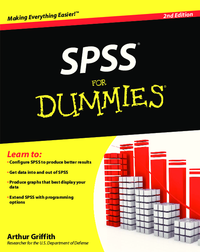
SPSS For Dummies
64 Visitas | 83 Descargas | 2016-08-26 13:15:18 | alejandromorales
This is fundamentally a reference book. Parts of the book are written as standalone tutorials to make it easy for you to get into whatever you’re after. Once you’re up and running with SPSS, you can skip around and read just the sections you need. You really don’t want to read straight through the entire book. That way leads to boredom. The book was designed to be used as follows: 1. Read the opening chapter so you’ll understand what SPSS is. I tried to leave out the boring parts. 2. If SPSS is not already installed, you may need to read about installing it. That’s Chapter 2. 3. Read the stuff in Chapter 4 about defining variables and entering data. It all makes sense once you get the hang of it, but the process seems kind of screwy until you see how it works. 4. Skip around to find the things you want to do. I would mention that you could skip the introduction, but it’s too late for that. Besides, you may find some information here that could be useful. One thing that needs to be clear from the beginning: This book is not about statistics. This book is about the things you can do to command SPSS software to calculate statistics for you.
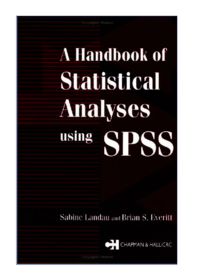
A Handbook of Statistical Analyses using SPSS
68 Visitas | 76 Descargas | 2016-08-26 13:17:25 | alejandromorales
SPSS, standing for Statistical Package for the Social Sciences, is a powerful, user-friendly software package for the manipulation and statistical analysis of data. The package is particularly useful for students and researchers in psychology, sociology, psychiatry, and other behavioral sciences, contain- ing as it does an extensive range of both univariate and multivariate procedures much used in these disciplines. Our aim in this handbook is to give brief and straightforward descriptions of how to conduct a range of statistical analyses using the latest version of SPSS, SPSS 11. Each chapter deals with a different type of analytical procedure applied to one or more data sets primarily (although not exclusively) from the social and behav- ioral areas. Although we concentrate largely on how to use SPSS to get results and on how to correctly interpret these results, the basic theoretical background of many of the techniques used is also described in separate boxes. When more advanced procedures are used, readers are referred to other sources for details. Many of the boxes contain a few mathematical formulae, but by separating this material from the body of the text, we hope that even readers who have limited mathematical background will still be able to undertake appropriate analyses of their data.
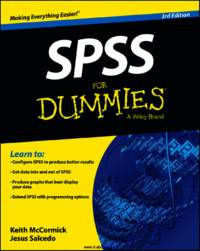
SPSS Statistics for Dummies 3rd edition
56 Visitas | 80 Descargas | 2016-08-26 13:22:22 | alejandromorales
This is fundamentally a reference book. Parts of the book are written as stand?alone tutorials to make it easy for you to get into whatever you’re after. Once you’re up and running with SPSS, you can skip around and read just the sections you need. You really don’t want to read straight through the entire book. That way leads to boredom. We know — we went straight through everything to write the book, and believe us, you don’t want to do that. This book is not about math. It’s about statistics. You don’t derive anything. You don’t do any math by hand or look up numbers in statistical tables. You won’t find one explanation of how calculations are performed under the hood. This book is about the things you can do to command SPSS to calcu- late statistics for you. The inside truth is that you can be as dumb as a post about statistical calculation techniques and still use SPSS to produce some nifty stats!

SPSS tutorial & exercise book for business statistics
68 Visitas | 71 Descargas | 2016-08-26 13:25:51 | alejandromorales
This exercise book was written for the students of the University of Miskolc within the framework of Business Statistics and Quantitative Statistical Methods. Some parts of the exercises are translated from the Hungarian book of Domán – Szilágyi – Varga: Statisztikai elemzések alapjai II, which are supplemented by SPSS exercises on the basis of SPSS 16.0 and 19.0 Tutorial. This book is a tutorial, which includes theoretical background just to understand the examples included.
Contribuir
Usted puede contribuir con Libros UCLV, es importante para nosotros su aporte..
Contribuir